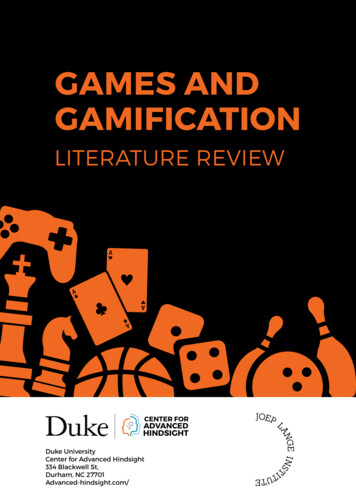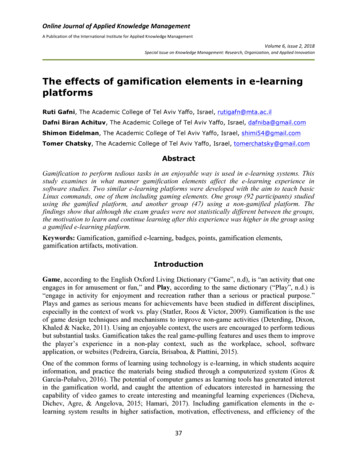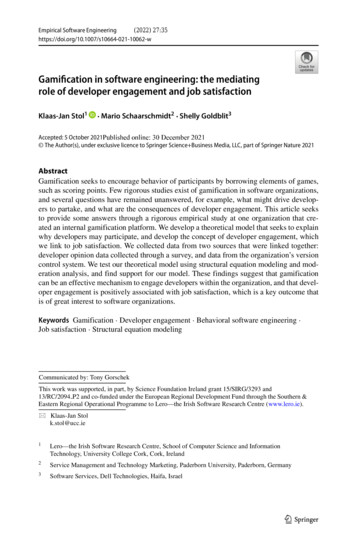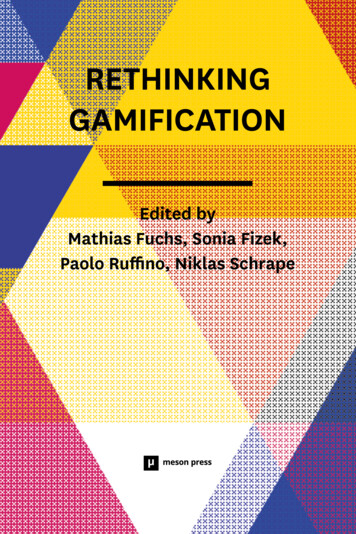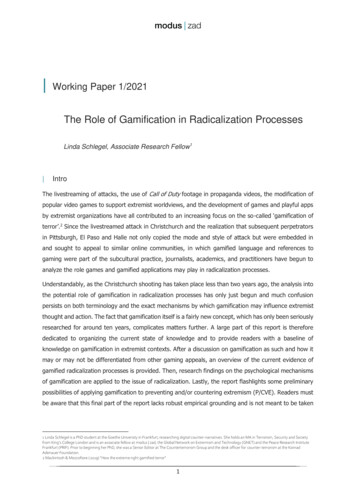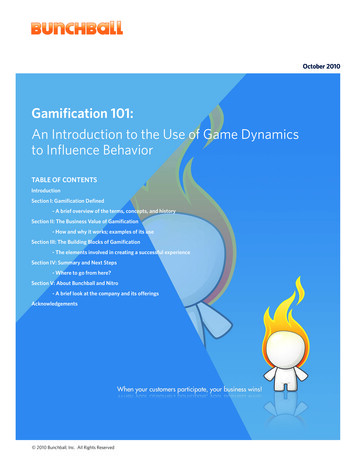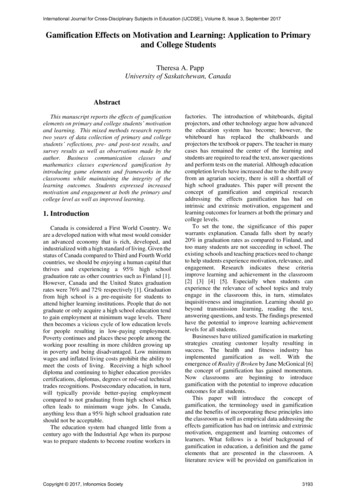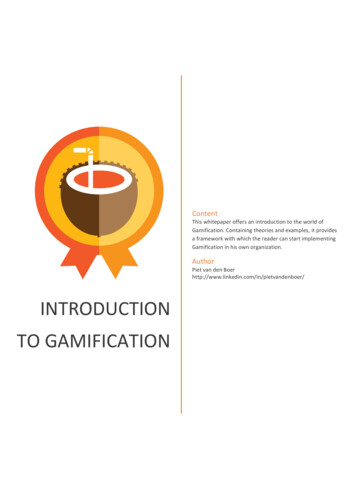
Transcription
ContentThis whitepaper offers an introduction to the world ofGamification. Containing theories and examples, it providesa framework with which the reader can start implementingGamification in his own organization.AuthorPiet van den ODUCTIONTO GAMIFICATION
Inhoudsopgave1 Introduction . 32 What is Gamification? . 42.1 Definition . 42.2 Game or Gamification?. 52.2.1 (Serious) Games. 62.2.2 Toys. 72.2.3 Playful design. 72.2.4 Gamification . 72.3 Famous examples of Gamification . 82.3.1 Foursquare . 82.3.2 LinkedIn . 82.3.3 Amazon.com . 82.4 Gamification and website optimization . 93 What can Gamification be used for? . 103.1 Promotion. 103.2 Employee productivity . 113.2.1 Nitro for Salesforce. 113.2.2 Work.com . 113.3 Behaviour change . 123.3.1 Foodzy – Healthy living . 123.3.2 UWV – Finding a job . 123.3.3 The Speed Camera Lottery . 123.4 Loyalty . 133.5 Education . 133.5.1 Classroom Game Design by Paul Andersen . 143.5.2 Codecademy . 144 What’s so engaging about games? . 155 Gamification Design Framework . 165.1 Define business objectives . 165.2 Delineate target behaviour . 175.3 Describe the players . 175.4 Devise the activity loops . 185.4.1 Engagement loops . 195.4.2 Onboarding and progression loops . 19Introduction to Gamification by Piet van den Boer - http://www.linkedin.com/in/pietvandenboer/1
5.5 Don’t forget the fun. 205.5.1 4 sorts of fun. 215.5.2 Encouraging fun. 235.6 Game elements . 235.6.1 Dynamics . 246.5.2 Mechanics. 246.5.3 Components . 246 Rewards . 256.1 Overjustification . 256.2 SAPS model . 25Links. 27Articles. 27Blogs . 27Courses and books . 27Events . 27Examples . 27Videos . 28Introduction to Gamification by Piet van den Boer - http://www.linkedin.com/in/pietvandenboer/2
1 IntroductionAlthough the term Gamification was already coined in 2002 by Nick Pelling, the subject has only recently foundits way to the marketing world. In recent years Gamification has gained popularity in marketing as shown byseveral Gamification seminars that are organized around the world, such as the Gamification Summits in theUnited States and Australia. Some relatively new some websites are dedicated to the Gamification subject,such as Gamification.org and Gamification.co. The E-learning platform Coursera even offers a Gamificationcourse from the University of Pennsylvania.The increasing popularity of games and the use of them in a business context isn’t at all surprising. It’s beenlong since videogames were only played by kids. For many adults, gaming is an important leisure activity. Theglobal games market has grown about 6% last year to an astonishing 70 billion USD.Console games still make up the biggest part of the games market (43%), but mobile is growing fast: 18% of thegames market is for mobile games, which is a 35% increase compared to 2012. Social games account for 9% ofthe game market. Although mobile games don’t even account for 20% of the total games market in 2013, 32%of the time spent on smartphones by Android- and iPhone users is for gaming. Facebook only accounts for 18%.Besides these numbers on the game market and the time spent on mobile gaming, there might be somethingmore fundamental going on: Games are an important part of our life, and everyone plays them. Whether it’swith a console or mobile, or in the offline world.The following video shows exactly how important games are in our daily lives:-Follow The Foot – Games we playIntroduction to Gamification by Piet van den Boer - http://www.linkedin.com/in/pietvandenboer/3
2 What is Gamification?2.1 DefinitionThe field of Gamification is still young and rapidly developing, so there are numerous opinions as to whatGamification exactly is. A popular – and striking – definition is:Gamification is the use of game elements and game thinking in non-gameenvironments to increase target behaviour and engagementGamification is about using-Game elements (not full-games)And game thinking (This doesn’t need to involve game technique, it’s more about the way games aredesigned and the idea behind games)In a non-game environment (commercial as well as not-for-profit environments)To increase target behaviour and engagement (target behaviour is central to this definition)The added value of Gamification isn’t limited to companies that are in a commercial environment. It can beused in any company or organization to increase target behaviour.For example, there’s Foldit. This is an initiative of several universities, research institutes and companies withthe goal to find cures for diseases like HIV/aids and Cancer. To find these cures, it’s necessary to understandthe protein structures of the human body.To understand this, the proteins are digitally folded into each other like a puzzle. Because there are so manydifferent possible structures and computers aren’t good at solving these puzzles, this is a time consuming jobfor scientists.Introduction to Gamification by Piet van den Boer - http://www.linkedin.com/in/pietvandenboer/4
By making the folding of proteins an actual puzzle and adding scores, leader boards and achievements, peopleall over the world can now help solving this problem. This way several enzyme structures have been found,some of which help finding cures for diseases like HIV/aids.2.2 Game or Gamification?It’s obvious that a game like Wolfenstein 3D or Fifa 2013 isn’t Gamification.Gamification is about using game elements outside games. A full game is notGamification.Heineken Star player has been developed to engage the viewers of theHeineken sponsored Champions League (soccer) games more with the brand.Although this is a very successful and engaging game, it’s a full game and notGamification.Besides full games there are several other subjects that can easily beconfused with Gamification. Serious games and Playful Design do have someconnection with Gamification, but are in fact something else.To make a clear distinction between the several subjects in this area, the following model has been developedby Deterding, Dixon, Khaled and Nacke in their paper ‘From Game Design Elements to Gamefulness: Defining“Gamification”.’Introduction to Gamification by Piet van den Boer - http://www.linkedin.com/in/pietvandenboer/5
Source: From Game Design Elements to Gamefulness: Defining “Gamification”In this model the most important elements in the Gamification spectrum distinguished from each other. Oneaxis differentiates between whole games and the use of game elements, the other axis differentiates betweenplaying and gaming.2.2.1 (Serious) GamesA game is characterized by rules, restrictions, meaningful choices andworking towards a goal, while these things are mostly missing in ‘play’.Serious games are a sub-category of games, for which the mostimportant goal is outside of the game itself. This can be the training ofpilots with a flight simulator game, or the training of doctors andsurgeons with the medical simulator Pulse.Introduction to Gamification by Piet van den Boer - http://www.linkedin.com/in/pietvandenboer/6
2.2.2 ToysToys are on the left side of the spectrum. They offer a whole experience,instead of using just parts of games. Yet there are no specific goals, rulesor meaningful choices which make it a game.Lego, Duplo and K’nex are great examples of this: Everything is possible,like recreate an Escher illusion (see picture on the right). If thecompetition element is added, a toy will most likely become a game.2.2.3 Playful designPlayful design is not a whole gaming experience, onlyparts of games (game elements) are used. Yet, also withPlayful design there are no specific goals, rules ormeaningful choices that make it a game or Gamification.Fun is the most important element. An example of this isthe idea for the ‘piano stairs’, which has been created fora Volkswagen project. In this project called ‘The funtheory’, consumers where asked to come up with ideas toencourage positive behaviour by making it more fun.One of the ideas was to encourage people to take thestairs instead of the escalator, by making the stairs lookand sound like a piano. Every touch of a stair results in a different note. When the piano stairs where build, alot of people initially where inclined to take the stairs. Because for them there wasn’t a clear goal, rules orrestrictions this is an example of Playful design.Watch the video:-Volkswagen – Piano Stairs2.2.4 GamificationGamification is on the right side of the spectrum. It doesn’toffer a whole gaming experience, but some gameelements are used. Although sometimes there’s someconfusion between Gamification and Playful design,there’s a clear difference: Gamification offers a clear andspecific goal to its users and has rules and restrictions thatmake it game-like. There’s a challenge to reach the goalsthat have been set. An example of Gamification in action isthe start-up PromiseUp. Their app offers people thepossibility to turn every promise they make into a bet.Plans to eat healthier? Or to exercise every week? Byturning it into a bet with their friends, PromiseUp users can earn badges and points. The adding of gameelements to a specific goal makes it a lot more fun to achieve personal goals.Introduction to Gamification by Piet van den Boer - http://www.linkedin.com/in/pietvandenboer/7
2.3 Famous examples of GamificationMore and more companies realise that games can be very powerful in changing human behaviour. Thereforeit’s not surprising that companies like Foursquare, LinkedIn and Amazon.com incorporate game elements ontheir websites and in their services.2.3.1 FoursquareTo Foursquare it’s important that users share their location with their friends on aregular basis. When users do that, value is being created for everyone in their socialnetwork. Without that the platform – obviously – doesn’t have a lot of value to users.By having people earn badges when they check-in on special places or with a certainfrequency, users are motivated to keep using Foursquare on a regular basis. Thebattle for mayorship in offices, bars and parks adds a competitive and social element that makes the behaviourstick.2.3.2 LinkedInLinkedIn makes money by selling advertisements. Theirad inventory can be sold for a higher price when theability to target these advertisements improves. If an adexactly reaches the people that are in the advertisers’target audience – and no one else – it’s worth a lot morethan when it has a lot of waste. This makes it importantfor LinkedIn to know their users very well, and one wayto get to know them is for users to fill in their profilesextensively.By acknowledging users with ‘strong profiles’ as Experts or All-Stars, people will be motivated to update theirprofiles regularly and fill out any information that’s missing. Another neat trick is the way the profile strengthballoon works: It can never be fully filled. There’s always room for improvement.2.3.3 Amazon.comEven the world’s biggest online retailer thankfullyuses the power of Gamification to improve itswebsite.The opinions of other customers – reviews – havea great influence on the buying decision of(online) customers. The challenge with customerreviews is not only the quantity of reviews, butalso the quality. The level of expertise as well asthe effort a customer has put in to write acomprehensive review is something that differs hugely between reviews. This means some reviews are a lotmore helpful than others.Introduction to Gamification by Piet van den Boer - http://www.linkedin.com/in/pietvandenboer/8
In order to improve the quality – and quantity - of reviews Amazon.com started the ‘Amazon’s Top Reviewers’program, which rewards customers for good quality reviews. By simply clicking ‘yes’ or ‘no’ next to a review,customers tell Amazon if a review has been helpful for them. The number of reviews a customer has writtenand the perceived quality translates into points, which are shown on the reviewers profile page. To increasethe competitive element, there’s also a leader board which ranks the reviewers publicly.2.4 Gamification and website optimizationGamification is growing in popularity with online marketers, but mostly in relation to website optimization.That link isn’t at all surprising: Website optimization is about improving websites to better influence thebehaviour of visitors and Gamification is a tool that can be very helpful in this regard.When it’s clear which behaviour should be encouraged on a website, several techniques can be used toaccomplish this. Persuasion techniques and optimizing the usability of a website are often used, butGamification can also help to stimulate certain behaviour.Several of these target behaviours have already been discussed in this chapter, like: Profile completion (LinkedIn)Improve review quantity (Amazon.com)Improve review quality (Amazon.com)Increase usage frequency (Foursquare)For each of these target behaviours it can be wise to use persuasion techniques – like Cialdini’s weapons ofinfluence – and optimize the usability of the website. However, game elements can also be very effective, ifused in the right way.Introduction to Gamification by Piet van den Boer - http://www.linkedin.com/in/pietvandenboer/9
3 What can Gamification be used for?As the previous chapter made clear, Gamification is a hot item among online marketers. However, there aremore fields besides online marketing, in which Gamification can be of use.For example, Gamification can be used for:1.2.3.4.5.PromotionEmployee productivityBehaviour changeLoyaltyEducation3.1 PromotionPrezi is a popular alternative to Microsoft PowerPoint.Because the service is hosted online and offers acompletely different way of presenting – zooming,turning, one big picture instead of regular slides – it hascertain advantages compared to its big competitor.A lot of marketers – and online marketers in particular – have probably used Prezi at least once. However,because it works completely different than the market standard – Microsoft PowerPoint –it’s a big challenge toget the general public to use Prezi. Therefore an important target demographic is students, at colleges as wellas universities. After all, they are the professionals of tomorrow. If they are used to work with Prezi, there’s agood chance they will continue to do so when they work at a company.To reach this group, Prezi has started the Prezi Ambassador Program. Students from all over the world canapply for an unpaid position as Prezi Ambassador for their campus. There’s only one Ambassador per campus.Each Ambassador writes a plan to make Prezi popular on their campus, for example by doing presentations andworkshops for other students. These activities will earn them points, status and Prezi merchandise. Moreoverthey compete against each other for big prizes like a trip to the Prezi offices in San Francisco and Budapest.Also, the work experience looks good on their resumes and sometimes it’s possible to earn college- oruniversity credits. The key game elements Prezi uses in this program are leader boards, points and status.This way Prezi uses Gamification to get students from all over the world to promote the service and recruit newusers.Introduction to Gamification by Piet van den Boer - http://www.linkedin.com/in/pietvandenboer/10
3.2 Employee productivityAnother use for Gamification is changing employee behaviour: Employees can be encouraged to shareknowledge, invest in personal development or do their work in a certain way.3.2.1 Nitro for SalesforceThe Nitro for Salesforce app is developed by Bunchball, specifically for the Salesforce platform.Salesforce is a Cloud platform that can be used tomake organization’s processes more efficient. Forexample CRM processes, inventory management,sales, internal collaboration and HR services.Nitro for Salesforce can be used within theSalesforce platform to gamify the sales process. Itallows managers to give points and rewards forspecific behaviour and to have employees competefor trophies, badges and status. This way themanager can change the way the sales teamoperates.For example, a manager can give points (orexperience) for:-Sales / revenuesCompleted customer profilesSharing specific information with colleaguesA certain amount of cold calls before the end of the weekVisiting a number of clients which the account manager hasn’t visited for at least a monthNitro uses trophies, leader boards and a points system. Also it’s possible to create specific quests thatemployees have to complete individually or as a team. For instance, when a certain product category doesn’treach its sales target, a manager can create a quest to get more leads, appointments and or sales in thiscategory. Or, when sales are always slow in summer, a summer competition can be created between districtsto try to compensate for the seasonality.3.2.2 Work.comWork.com – previously Rypple – is a successfulstart up in the field of performance evaluation andtalent development, now owned by Salesforce.Instead of an assessment cycle in which employeesget two feedback moments a year, work.com triesto create an environment of continuous feedback.Employees and managers can set goals, on whichthe managers as well as other employees can givefeedback. When employees reach their goals theyearn points and badges. Because the app isavailable via desktop as well as mobile, employees are always up to date and able to give feedback to eachother. Among the clients that have arranged their HR cycle with Work.com are companies like Facebook andSpotify.Introduction to Gamification by Piet van den Boer - http://www.linkedin.com/in/pietvandenboer/11
3.3 Behaviour changeGamification works best when it stimulates behaviour that people already pursue or find worthwhile.Behaviour that doesn’t come easy, behaviour for which people have to work. For example healthy living,finding a job or keeping to the speed limit.3.3.1 Foodzy – Healthy livingFoodzy is an Amsterdam start up that helps people finding the perfectbalance in their diet. A Foursquare for food you might say. Everythinga user eats, he / she can check-in with the Foodzy app. Foodzy willthen calculate and report the number of calories per item or perperiod of time. Users can set goals for healthy living, compare and compete with friends and earn badges forhealthy – and sometimes unhealthy – behaviour. Also the app can be connected to hardware like the Fitbit –which measures movement and calorie burning – to provide as much insight as possible in the users’ health.3.3.2 UWV – Finding a jobThe UWV is a Dutch government organization that among other things like paying out unemploymentbenefits - helps people to find a job. It’s their goal toget people that are unemployed a back to work assoon as possible. To increase chances onemployment, it’s important to have a relevant andcomplete resume, to look for work in the rightplaces and to be well prepared for interviews. That’snot something that comes easy to everyone,especially to people that are new on the job market.This is why the UWV aims to help young people finda job, using the gamified program ‘Expeditie Work’.In Expeditie Work, players have to complete several levels, which contain quizzes, challenges, assignments andmini-games that help them find a job. They learn about the right places to look for jobs and how to approachfinding a job, they make their own resume and practice interviews.Expeditie Work shows that the dividing line between Gamification and Serious Games can be very thin. A fullgame experience is offered, yet a lot of the activities the player must undertake – like applying for jobs - areoutside the digital game. Even the end goal of finding a job is not within the game.3.3.3 The Speed Camera LotteryThe Volkswagen project ‘The Fun Theory’ has produced more than justthe Piano Stairs. Another interesting winner was the Speed CameraLottery, which is an example of Gamification. The Speed Camera Lotterystarts with one simple question: Wouldn’t it be more fun and moreeffective to reward people if they keep to the speed limit, instead ofjust punishing those who don’t?The Speed Camera Lottery works as follows: Every car that drives past the speed camera is photographed.Every time someone passes the camera and keeps to the speed limit, he or she enters the lottery to win a cashprize. The prize is paid from the fines to the people that don’t keep to the speed limit.Introduction to Gamification by Piet van den Boer - http://www.linkedin.com/in/pietvandenboer/12
In Stockholm an experiment with the Speed Camera Lottery has been performed. During this experiment theaverage pace of passing cars went down with 22%.Watch the video:-The Fun Theory – The Speed Camera Lottery3.4 LoyaltyA person who feels loyalty to a nation, cause, or person feels a sense ofallegiance, commitment, dedication toward themLoyalty is what most marketers are looking for in their customers. When translated into actions it can meanrepeat purchases or contract renewals. The following are conditions for- or predictors of loyalty:-Word of mouthProduct ownership – more products per person predicts a higher loyaltyBrand knowledge and brand preferenceEngagementThese are all forms of behaviour which Gamification can help to encourage. A lot of companies use loyaltyprograms already. For example Texaco has Rocks’, Jet Blue has TrueBlue and Amazon has Prime. Yet, a loyaltyprogram isn’t necessarily Gamification. After all, where are the game elements in Rocks? Or the competitionand social interaction in Prime? Rewarding customers for repeat purchases can have a significant effect onloyalty, but it isn’t necessarily Gamification.GetGlue is a service that encourages loyalty for TV-seriesand films. The service works a lot like Foursquare, butinstead of checking in on locations the users check-in TVseries and films. Users that watch certain TV-series often,or have watched a lot of series in the same genre canearn badges. Also the most loyal followers of specificseries can be rewarded with previews or behind thescenes material.The social aspect enhances the effect it has on loyalty, asusers share their ‘accomplishments’ and check-ins on GetGlue via Facebook and other social networks. Theycan also follow each other, discover new series and discuss episodes and plot twists.3.5 EducationIn general, players are very involved with the games they play. This involvement – or engagement – is one ofthe great challenges in educations. To motivate students to study and keep them engaged until the end of asemester isn’t easy. Educational institutions could learn from games in this regard.Education might even be the profession which can progress most by implementing Gamification techniques,because of the parallels between learning and gaming. In gaming it’s all about completing levels, overcomingobstacles and obtaining certain skills, whereas education revolves around progression to the next grade,passing exams and obtaining knowledge and skills.Introduction to Gamification by Piet van den Boer - http://www.linkedin.com/in/pietvandenboer/13
Another element that’s important in both cases is social interaction. This is integral to classrooms and one ofthe things that makes games engaging.All these similarities to games considered, it should be a piece of cake to motivate and engage students.Although it’s not that simple, there are some basic game elements that are often used in successful applicationof Gamification in education:-Feedback – Instant feedback, make sure the students a
Gamification is the use of game elements and game thinking in non-game environments to increase target behaviour and engagement Gamification is about using -Game elements (not full-ga
